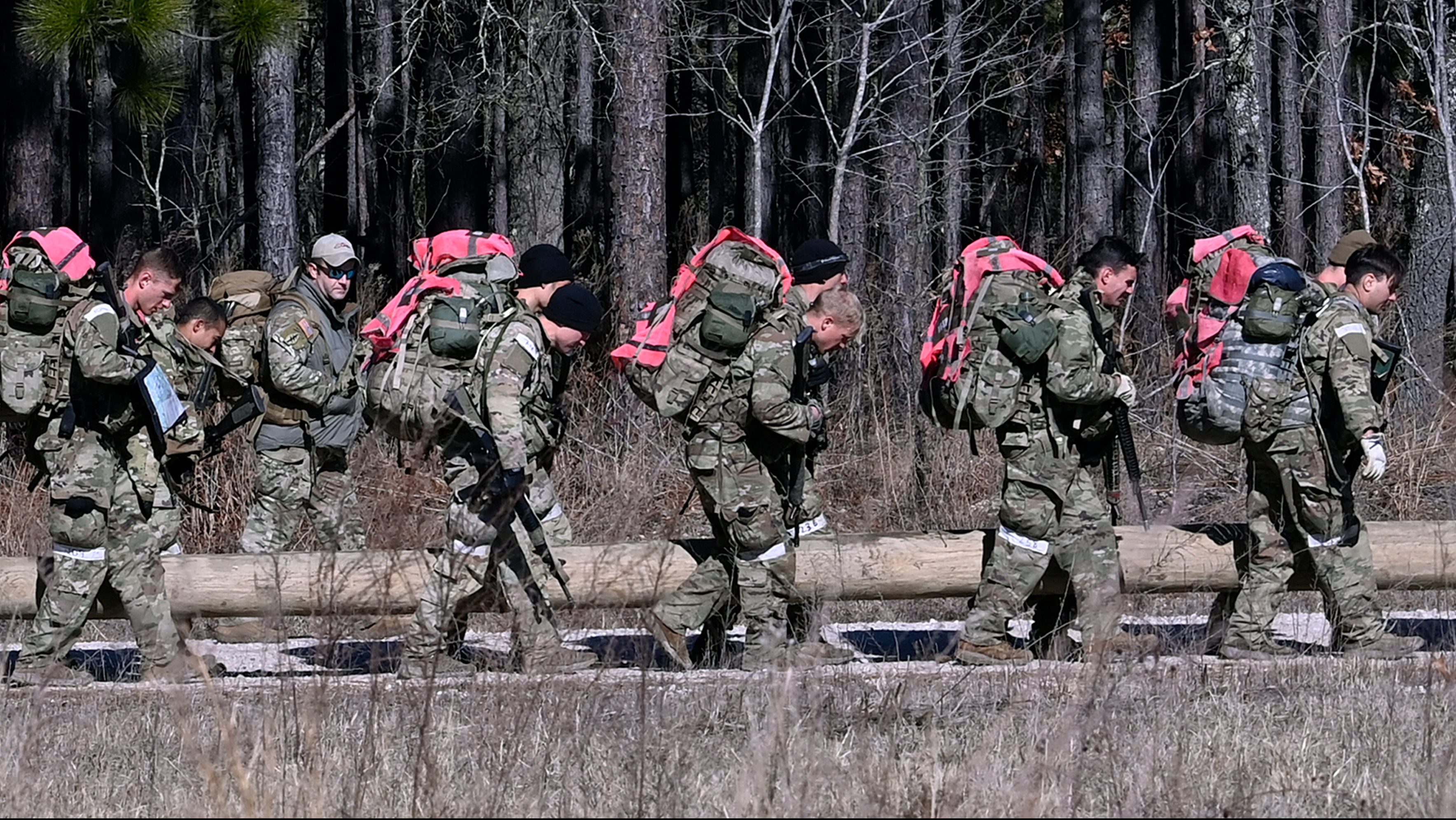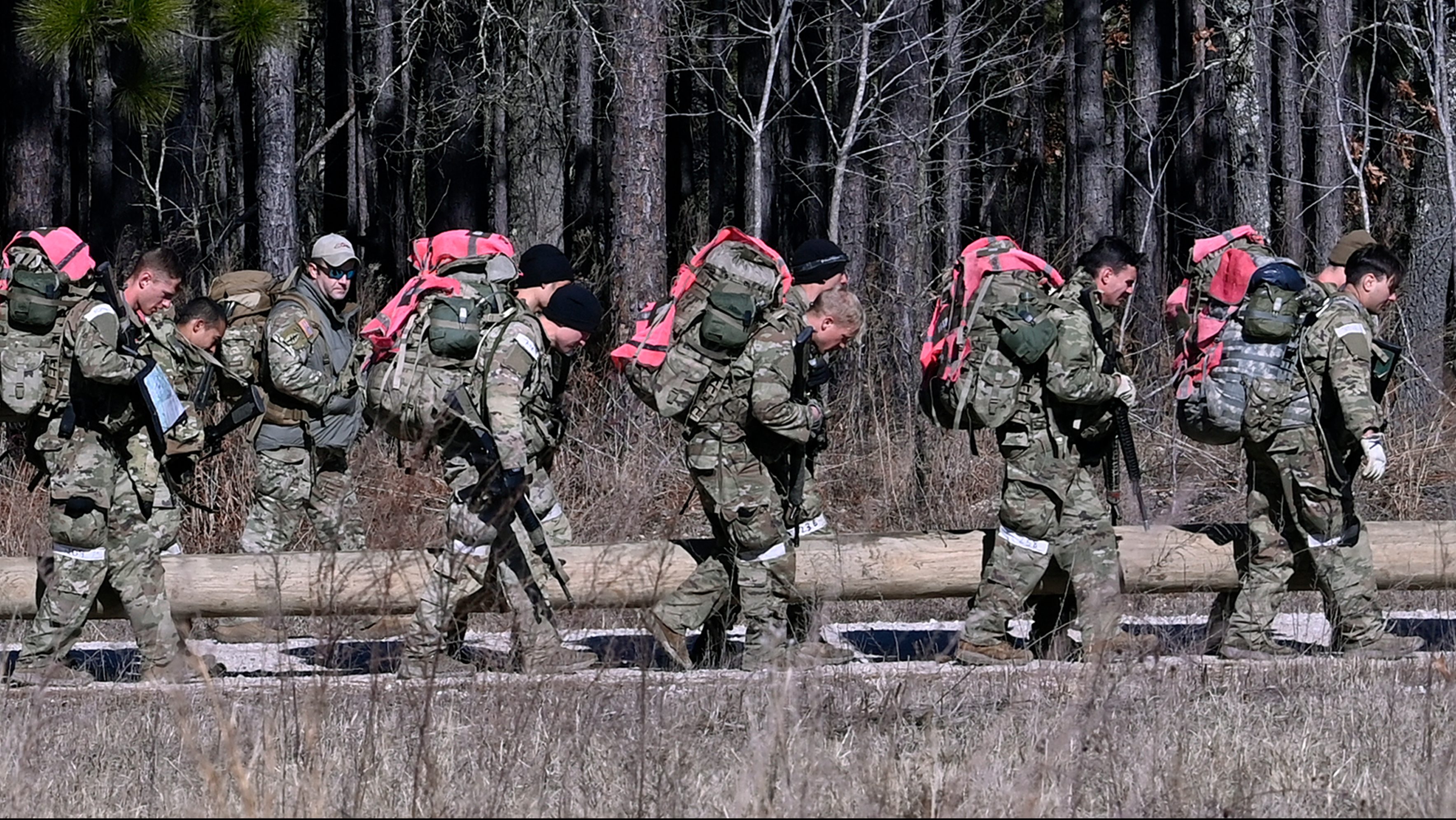

Before Green Berets eat snakes and carry out guerrilla warfare around the world, they must all pass the U.S. Army’s Special Forces Assessment and Selection, or SFAS. It’s the first part of the Special Forces pipeline. Unlike late training, the goal of SFAS is not to teach students new skills or equipment but to stress their ability to perform at a high level, both physically and mentally.
The Soldiers selected at the end of SFAS move on to the formal portions of the Special Forces Qualification Course (Q course), where soldiers learn the fundamentals of being a Green Beret..
Task & Purpose talked to two current instructors or Green Berets who participate in the training at SFAS to understand how the school selects candidates and agreed to only refer to some by their real first names. Chad, who has served as non-commissioned officer in charge of the school, said that candidates should not worry about teaching themselves field skills like radio setups or shooting techniques before arriving at Ft. Liberty.
“We’re gonna provide them really any training they need to do to be successful here, particularly if they’re coming off the street. […],” Chad said. “They’re going to need to be successful here during the evaluation. What they can do on their time is to work on the things that they can control internally, primarily being their physical fitness, and then have a reason for why they want to be here and a reason not to quit when things get difficult.”
A brief history of Special Forces Assessment and Selection
SFAS was the brainchild of Brigadier General James Guest, who commanded the John F. Kennedy Special Warfare Center and School during the mid-1980s. Guest devised the three-week assessment and selection process to ensure a better quality of soldiers were selected for Special Forces.
During the 1950s, the Army created special-mission units known as Special Forces. Volunteers would undergo difficult training selection was not separate from the training course. To professionalize the selection process, Guest ordered SFAS brought online and the first class was held on June 12, 1988. A year later, 1st Special Warfare Training Group was activated with three training battalions and one support battalion.
The early classes were rough. Retired Sgt. 1st Class Adam Klakowicz went through SFAS in 2005, and remembers brutal sessions of “log PT.”
“That one was fuckin’ dudes up. I saw two guys get hurt in the pit with the logs during SFAS. They don’t do that anymore, and for good reason, because they determined it’s where guys are getting hurt the most. So they took it out,” Klakowics said. “So when people are like, ‘When I went through, guys were getting broke off left and right,’ and I’m like, ‘Yeah, that’s not the fucking answer, man.’ I want to see what you got, but this ain’t the way to test it.”
Log PT is gone, but the Green Berets running SFAS have found better ways to test a candidate’s mental and physical fortitude.
How long is Special Forces Assessment and Selection?
SFAS is 24 days long but can fluctuate by multiple days depending on weather and training stand-downs. It may not seem like much, but don’t let the number of days fool you.
“So assessment and selection does get progressively more difficult as the course moves on. However, because we are looking at the whole person, there isn’t a single event that is going to be a deal breaker for most individuals. It’s really going to depend on the individual,” Chad said.
There are no phases within SFAS, and the exact curriculm is kept close to the vest by instructors but the events are relatively well known. Candidates can expect lots of PT events, including tire flips, weight drags and low crawls across training fields.
Teamwork events long ruck movements carrying parts and pieces of broken vehicles and structrues, like metal poles, truck wheels and other heavy, akward items. Instructors note how candidates work together to spread the load and find innovative ways to use the off-hand pieces they are given.
Another event includes the STAR course, a grueling nighttime land navigation course that students are tested on well into assessment and selection.
“We’re looking at the whole person and trying to get an assessment of their overall capability and ability to demonstrate the [Army Special Operations Forces] attributes, we’re looking at multiple events over multiple days prior to making the final assessment on a candidate
SFAS is the ticket to enter the Q-course, which consistrs of four phases. This is where the selected candidates qualify under one of five Special Forces military occupation specialties: medic, communications, weapons, engineering and officers. After qualifying on their own .
Special Forces Assessment and Selection requirements
Why do students quit? Most soldiers who show up for SFAS have trained for months if not years and are well aware of the challenge. Travis, an SFAS senior assessor, said cadre at the school often ask why soldiers quit during SFAS.
“You’ll have guys quit and then give an explanation of why they quit,” Travis said. “A lot of times guys will write down on the paper they have troubles back home that they’d rather go home than continue on with the course.”
Chad echoed that sentiment and had recommendations on preventing home life issues from causing people to quit.
“I would say the best thing a potential candidate can do is, prior to attending SFAS, try to ensure that all of those personal affairs are in order as best they can. Then, if they are successful here, ensure that all those personal affairs are in order prior to moving their family to Fort Liberty and starting the Special Forces Qualification Course.”
However, several mandatory requirements exist for enlisted and senior enlisted personnel. All who attend SFAS must pass a special forces physical assessment before arriving at Camp Mckall, located at Ft. Liberty, North Carolina.
For enlisted ranks of E-3 to E-7, they must be eligible for a secret clearance, have a minimum ASVAB General Technical score of 100 or above, and have the ability to reclassify from your current MOS or branch. Enlisted soldiers must also have a minimum of 36 months remaining time in service at the time of Q-course graduation and have less than 30 days of lost time under USC 972 within current or preceding enlistments.
However, there are some differences between lower and senior enlisted (E-7) ranked soldiers.
Enlisted (E-3 to E-6):
- Minimum rank of E-3
- Must be 20 years old at the start of SFAS (requires a waiver)
- No older than 36 years old (waiverable)
- No more than 14 years time in service
Senior enlisted (E7):
- No more than 12 years time in service and nine months time-in-grade when applying for the
- SFAS course
- ?Either Airborne or Ranger qualified
- Must attend SFAS within 90 days of volunteering and be able to PCS to the Q course within 6 months of selection at SFAS
- You must sign a Master Sergeant (MSG) declination statement prior to attending the Q course
Officer:
- Pay grade of O-1(P), O-2, or O-3 and in the targeted year group for the captain’s board
- Must have at least a secret security clearance prior to final packet approval and be eligible for a Top Secret clearance
- Must have completed the Officer Basic Course
- Must have been successful in your branch assignments prior to applying to SF
Special Forces Assessment and Selection preparation
Klakowicz joined the Army to compete on the All Army Boxing Team and eventually won the 2004 U.S. Forces Europe boxing championship. But his commander at the time denied his request to try out for the All Army team, so he decided to try something else. That’s when he discovered the road to becoming a Green Beret.
“I had two really good pieces of advice, one from the boxing gym, and one from my dad,” Klakowicz said. “From the boxing gym was, ‘you can be the greatest athlete in the world, but how about this? You go dribble your basketball, and I’ll punch you while you do it, and we’ll see how good you really are at it.’” Klakowicz said. “Remember, no matter what else you do outside of this gym, nobody’s going to be punching you. And my dad gave me a piece of advice around February 2005 before I stepped off in March, and he was like, ‘Hey, man, check it out. It’s Army training. They’re not going to kill you, and it has to end. He’s like, just make it to the end.’”
Those two pieces of advice helped Klakowicz grit his teeth and push forward through the difficulties of selection. But, he said a big help was his state of physical fitness, having just finished a major boxing match before shipping out to Ft. Liberty, then Ft. Bragg. Klakowicz said showing up uninjured and in the best physical shape possible is the key to being successful in SFAS.
Klakowicz had prepared physically through his fight training, but he also had a six-week training program from the SF recruiters that taught him how to prepare his body for long ruck marches and how to take care of his feet. That program is outdated today, but Chad recommended precisely following their current day workout programs provided on the SF website.
What is Special Forces Assessment and Selection really like?
Part of the challenge of SFAS, instructors say, is not knowing what the standards are.
“We can’t disclose standards throughout the course that are going to result in a candidate being dropped,” Chad said. “What we can disclose are the standards for the initial physical fitness test that will allow them to start the course.”
The current standards for the fitness test are 28 hand-release push-ups, six pull-ups, and a 15:12 two-mile run time. If candidates fail to achieve any of those standards, they will be automatically dropped from the course on the first day.
“Now, what we can identify are some of the things that candidates can do that are indicative of success out here at SFAS, such as running a sub 13:32 two-mil run while being able to do over 30 hand-release push-ups, performing over 12 Pull Ups, and being able to ruck at sub-15-minute mile pace,” Chad said.
Every skill that candidates are evaluated on comes with a block of instruction from the cadre. The difficulty is whether candidates can quickly digest the information and physically carry out what is asked of them.
That’s everything that the current command said, and Klakowicz agreed with that, though he pointed out that the STAR course is infamously difficult because it’ll be the first time candidates are “alone and afraid.”
It’s difficult training, no matter how you look at it, but Klakowicz said there are moments of fun when you “embrace the suck.”
“You weren’t supposed to wear stuff like Under Armour underwear, like that heat-dissipating underwear,” Klakowicz said. “I wore boxers, and the cadre had us all out there and ordered us to drop trou. Some dudes were just butt-ass naked out there, and some were shaking their dicks around in formation and had the cadre laughing. That shit was pretty funny, man.”
FAQs about Special Forces Assessment and Selection
You have questions, Task & Purpose has answers.
Q: How long is SFAS?
A: SFAS is 24 days long but can fluctuate by a few days.
Q: How hard is SFAS?
A: The difficulty is relative and can depend on how well you prepare. But, the attrition rate of SFAS is as low as 57% up to as high as 75%.
Q: What is the hardest part of SFAS
A: SFAS becomes progressively more difficult as each day passes, but one of the cadre said the star course is one of the toughest events of SFAS.
Q: Do you have to eat a live snake to pass SFAS?
A: That’s classified.
